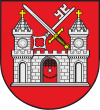Derpt
| Tartu | |||
|---|---|---|---|
| City | |||
| Tartu linn City of Tartu |
|||

From top to bottom: City Centre, Old Town of Tartu, University of Tartu
|
|||
|
|||
| Motto: Heade mõtete linn ("City of good thoughts") | |||
| Location in Estonia | |||
| Coordinates: 58°23′N 26°43′E / 58.383°N 26.717°ECoordinates: 58°23′N 26°43′E / 58.383°N 26.717°E | |||
| Country |
|
||
| County |
|
||
| First settled | 5th century AD | ||
| First mentioned | 1030 | ||
| City rights | before 1262 | ||
| Named for | Taara or tarvas (Aurochs) | ||
| Government | |||
| • Mayor | Urmas Klaas (Reform Party) | ||
| Area | |||
| • Total | 38.80 km2 (15 sq mi) | ||
| • Land | 37.9 km2 (14.6 sq mi) | ||
| • Water | 1.3 km2 (0.5 sq mi) 3.39% | ||
| Elevation | 57.2 m (188 ft) | ||
| Highest elevation | 79 m (259 ft) | ||
| Population (2016) | |||
| • Total | 93,687 | ||
| • Density | 2,508.6/km2 (6,497/sq mi) | ||
| Ethnicity | |||
| • Estonians | 80.1% | ||
| • Russians | 14.6% | ||
| • other | 5.3% | ||
| Time zone | EET (UTC+2) | ||
| • Summer (DST) | EEST (UTC+3) | ||
| Postal code | 50050 to 51111 | ||
| Vehicle registration | T | ||
| Website | tartu.ee | ||
Tartu (Estonian pronunciation: [ˈtɑrtˑu], South Estonian: Tarto) is the second largest city of Estonia, after Estonia's political and financial capital Tallinn.
Tartu is often considered the intellectual centre of the country, especially since it is home to the nation's oldest and most renowned university, the University of Tartu. The city also houses the Supreme Court of Estonia, the Ministry of Education and Research and the new impressive building of the Estonian National Museum opened to public on October 2016.
It is also the birthplace of Estonian Song Festivals.
Situated 186 kilometres (116 miles) southeast of Tallinn and 245 kilometres (152 miles) northeast of Riga, Tartu lies on the Emajõgi ("Mother river"), which connects the two largest lakes of Estonia. The city is served by Tartu Airport.
Since 1918, the Estonian name Tartu has been used, but as the town has come under control of various rulers throughout its history, there have been various names for it in different languages. Most of them derive ultimately from the earliest attested form, the Estonian Tarbatu. In German, Swedish and Polish the town has been known and is sometimes still referred to as ![]() Dorpat , a variant of Tarbatu. In Russian, the city has been known as Юрьев (Yur′yev, after Yuri, the baptismal name of Grand Prince Yaroslav I the Wise) and as Дерпт (Derpt, from the Low German variant of Dorpat). Similarly, the city has been known as Tērbata in Latvian, while Finnish-speakers use the toponym Tartto.
Dorpat , a variant of Tarbatu. In Russian, the city has been known as Юрьев (Yur′yev, after Yuri, the baptismal name of Grand Prince Yaroslav I the Wise) and as Дерпт (Derpt, from the Low German variant of Dorpat). Similarly, the city has been known as Tērbata in Latvian, while Finnish-speakers use the toponym Tartto.
...
Wikipedia



